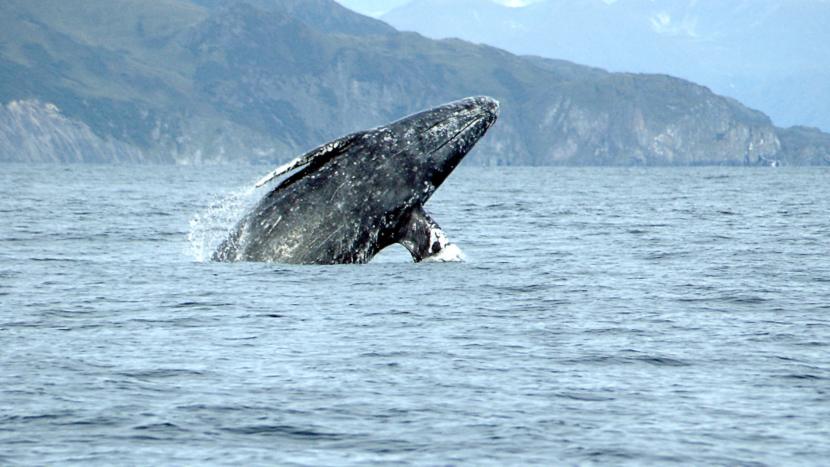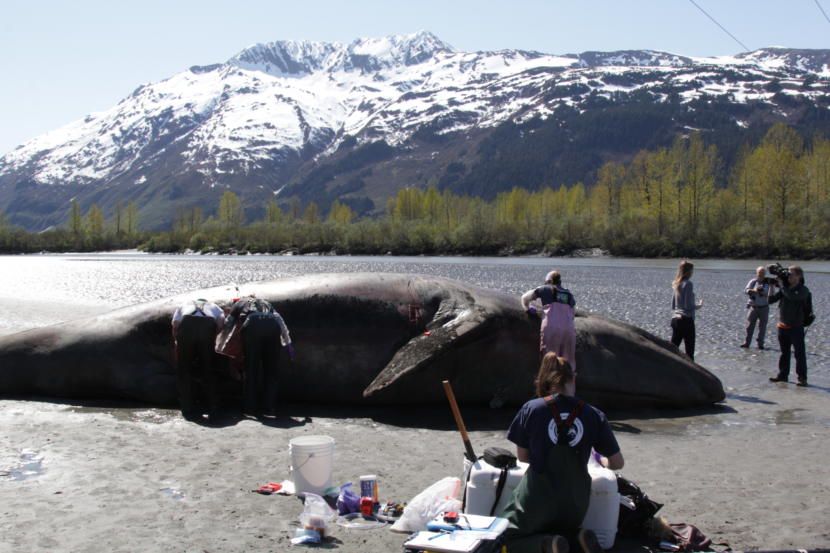
Scientists say it will probably be a long time before they can confidently explain the spike in gray whale deaths along the Pacific Coast, including in Alaska.
But one big question they’re now exploring is how warming waters in the Arctic, where the whales feed, could be connected – especially since many of the dead whales have appeared underfed.
“It’s hard not to tie the two together, given that that’s why these whales come to Alaska every year,” said Bob Foy, who directs a Seattle-based federal fisheries research center that’s part of the National Oceanic and Atmospheric Administration. “The timing of there potentially being a feeding issue is right, in terms of overlapping with these changes in the ecosystems that we’ve seen.”
Gray whales aren’t exactly the easiest animals for scientists to track. First, they live in the ocean, making their movement and feeding patterns hard to follow.
And twice each year, they go on one of the world’s longest known mammal migrations, swimming 5,000 miles between their winter area in Mexico and their summer feeding grounds in the Arctic.
That means there could be a number of causes of the spike in deaths that scientists have documented this spring.
But a lot of the attention is going toward the Arctic.
The region is warming twice as fast as the rest of the world, and scientists have observed record-low levels of sea ice in the past few years. As a result, the ocean ecosystem there is in “state of flux,” Foy said.
That has to do with the way sea ice affects the marine food web and the growth of the tiny phytoplankton that form its base.
When ice is present late into the spring, it creates conditions that cause most of the phytoplankton to fall all the way to the ocean floor, known as the benthos. At the bottom, the phytoplankton supports an ecosystem dominated by invertebrates, like crabs and sea stars – there aren’t typically a lot of fish like cod and pollock swimming around. And that “benthic-dominated” ecosystem is what supports gray whales’ primary prey – shrimp-like creatures called amphipods.

But when the sea ice retreats earlier, more of the phytoplankton is eaten by a different species of plankton called zooplankton. The zooplankton then supports fish and other species above the ocean floor that are normally found farther south, like pollock and cod. But it means less of the phytoplankton is left to fall to the ocean floor and support the sea life there – including, potentially, the amphipods that gray whales like to eat.
“The result of that change in the food web could very definitely lead to a lower amount of food available on the bottom of the ocean,” Foy said.
This isn’t a theoretical concept, either. In the past few summers, researchers from Foy’s center have documented huge populations of cod and pollock invading areas of the northern Bering Sea, where they’d never been seen in such numbers.
Scientists don’t yet have enough information specific to gray whales to label climate change or declining sea ice as the smoking gun, Foy said. But they’ve seen enough other events that have come along with Arctic warming, like sea bird die-offs, that they’re asking questions.
“I don’t think we’re going to put all our eggs in that basket. There’s a number of other potential sources of harm that could explain this,” Foy said. “Once we have an opportunity to collect all of these data, we’ll have an opportunity to put a better story together.”
Federal scientists from Foy’s research center will be out on boats on the Bering Sea and the Gulf of Alaska this summer and fall, gathering information on fish and plankton that could help them explain what’s happening to the whales.
Scientists haven’t ruled out an outbreak of disease, and they’re also looking at how the whales’ steadily increasing population might play a role. But warming oceans are definitely one possible explanation.
Or, they could be complicating or exacerbating another phenomenon, said John Calambokidis, a research biologist and whale expert at the Washington-based Cascadia Research Collective. Arctic warming alone doesn’t seem like a perfect explanation, he said, since warmer conditions have occurred over several years and the spike in deaths only began this spring.
“It doesn’t hold water as the sole factor. That doesn’t mean it might not have some role,” Calambokidis said. “I’m totally supportive of this as a key issue that we need to pay attention to. Because it has huge implications.”
